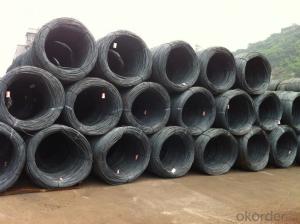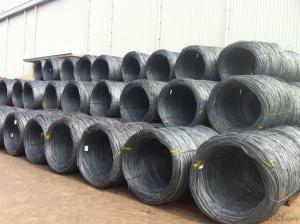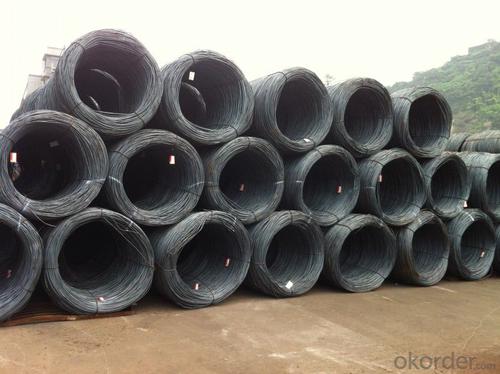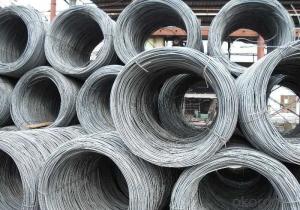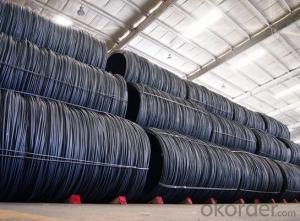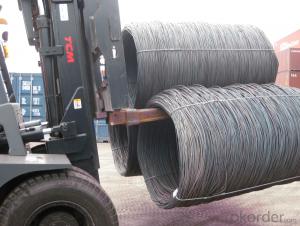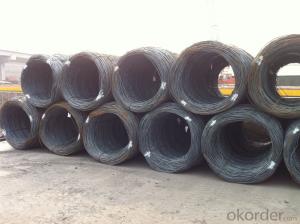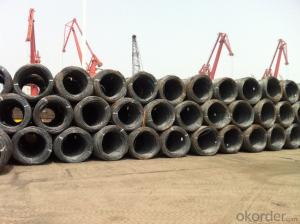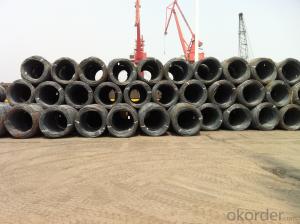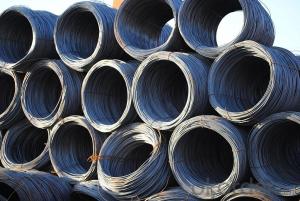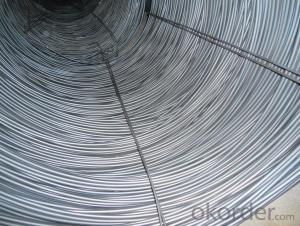Wire rod SAE 1006-1018 with highest quality and lowest price
- Loading Port:
- Tianjin
- Payment Terms:
- TT OR LC
- Min Order Qty:
- 25 m.t.
- Supply Capability:
- 10000 m.t./month
OKorder Service Pledge
OKorder Financial Service
You Might Also Like
Product Description:
OKorder is offering high quality products at great prices with worldwide shipping. Our supplier is a world-class manufacturer of steel, with our products utilized the world over. OKorder annually supplies products to European, North American and Asian markets. We provide quotations within 24 hours of receiving an inquiry and guarantee competitive prices.
Product Applications:
After hot-rolled the products shaped into coil and delivery as finished product, including round, square, rectangular, hexagonal and so on, Since most of the products are round, it is generally called wire rod. Steel wire rod is widely used in construction and manufacturing. Steel wire rod is mainly used for reinforcement of reinforced concrete and welded structure or reprocessed (roberts, nail etc) materials, especially used to produce wire drawing, welding electrode, nails,spring, electronic, precise machinery parts and so on.
Product Advantages:
OKorder's wire rods are durable, strong, and resist corrosion.
Main Product Features:
· Premium quality
· Prompt delivery & seaworthy packing (30 days after receiving deposit)
· Corrosion resistance
· Can be recycled and reused
· Mill test certification
· Professional Service
· Competitive pricing
Product Specifications:
Manufacture: Hot rolled
Grade: SAE1006-1018
Certificates: ISO, SGS, BV, CIQ
Packaging: Export packing, nude packing, In Coils
Grade | Chemical Composition (%) | |||||
C | Mn | S | P | Si | B | |
SAE1006B | 0.03~O.07 | 0.32max | 0.045max | 0.040max | 0.30max | 0.0008min |
Mechanical properties | ||||||
Yield strength(N/mm2) | Tensile strength(N/mm2) | Elongation (%) | ||||
250-280 | 350-380 | ≥32 | ||||
Grade | Chemical Composition (%) | |||||
C | Mn | S | P | Si | B | |
SAE1008B | 0.10max | 0.3~0.50 | 0.050max | 0.040 max | 0.15max | 0.0008 min |
Mechanical properties | ||||||
Yield strength(N/mm2) | Tensile strength(N/mm2) | Elongation (%) | ||||
≥195 | 315-430 | ≥30 | ||||
FAQ:
Q1: Why buy Materials & Equipment from OKorder.com?
A1: All products offered byOKorder.com are carefully selected from China's most reliable manufacturing enterprises. Through its ISO certifications, OKorder.com adheres to the highest standards and a commitment to supply chain safety and customer satisfaction.
Q2: How do we guarantee the quality of our products?
A2: We have established an advanced quality management system which conducts strict quality tests at every step, from raw materials to the final product. At the same time, we provide extensive follow-up service assurances as required.
Q3: How soon can we receive the product after purchase?
A3: Within three days of placing an order, we will begin production. The specific shipping date is dependent upon international and government factors, but is typically 7 to 10 workdays.
Images:
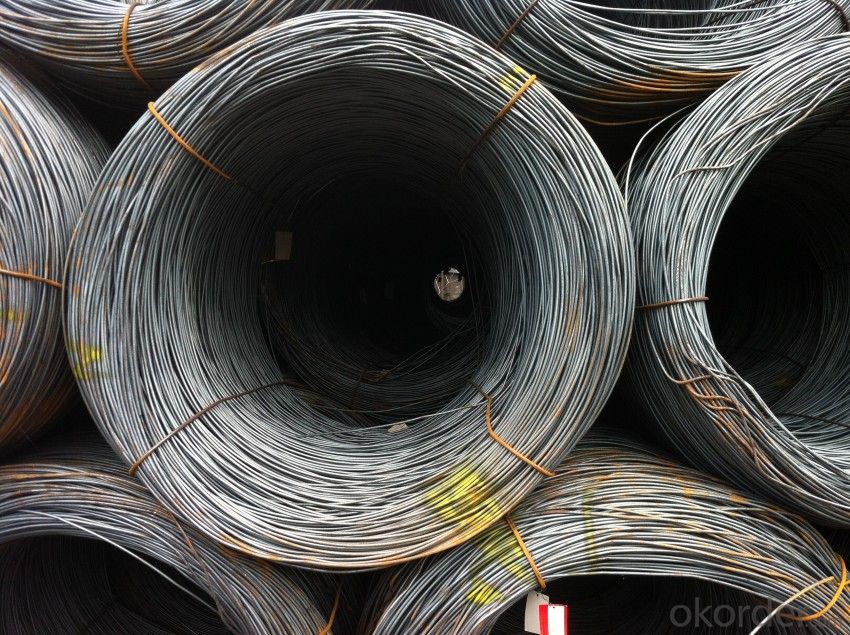

- Q: How is steel wire rod used in the manufacturing of wire forms for musical instruments?
- Steel wire rod is an essential component in the manufacturing of wire forms for musical instruments. It serves as the base material for creating various wire shapes, such as springs, hooks, and braces, which are crucial for holding instrument parts together or providing tension. The high-quality and strength of steel wire rod ensure durability and reliability in these wire forms, enabling musicians to produce precise and harmonious sounds from their instruments.
- Q: What are the different types of steel wire rod cooling methods?
- The industry commonly uses various steel wire rod cooling methods, aiming to efficiently cool down the wire rod after hot rolling mill processing. Depending on the desired properties and specifications of the wire rod, cooling methods can vary. A cost-effective and energy-efficient cooling method is air cooling, where the wire rod is exposed to ambient air, allowing natural convection to dissipate heat. However, this method may not be suitable for all applications as it may not provide the desired cooling rate or uniformity. For a high cooling rate and quick solidification, water cooling is utilized. This involves spraying water onto the wire rod. It is widely used in high-speed wire rod mills where achieving desired mechanical properties requires a fast cooling rate. In specific applications where specific hardness or strength is required, oil quenching is used. Wire rods are rapidly cooled by immersing them in oil, such as mineral oil or polymer-based oil. Controlled cooling rates achieved through oil quenching result in the desired microstructure and mechanical properties. Advanced cooling methods incorporate innovative technologies such as forced air cooling and water mist cooling. Forced air cooling employs high-velocity air jets to rapidly cool the wire rod, while water mist cooling uses a fine mist of water droplets for efficient cooling. These methods offer enhanced cooling rates and can be tailored to specific requirements. In conclusion, steel wire rod cooling methods include air cooling, water cooling, oil quenching, forced air cooling, and water mist cooling. Each method has its advantages and is chosen based on the desired properties and specifications of the wire rod.
- Q: What are the main trends in the steel wire rod industry?
- The steel wire rod industry is experiencing several key trends that are shaping its future. One of the main trends is the increasing demand for steel wire rods in various industries, including construction, automotive, and manufacturing. The construction industry, in particular, is driving the demand for steel wire rods due to the growth in infrastructure projects worldwide. The automotive industry is also a significant consumer of steel wire rods for the production of components such as springs, wires, and cables. As these industries continue to expand, the demand for steel wire rods is expected to increase. Another important trend is the shift towards higher quality and more advanced steel wire rods. With the growing emphasis on sustainability and energy efficiency, manufacturers are seeking steel wire rods that offer superior strength, durability, and corrosion resistance. This has led to the development of innovative steel wire rod grades and processes that deliver enhanced performance characteristics. Additionally, the increasing use of advanced technologies, such as microalloying and controlled cooling, has enabled the production of high-quality steel wire rods with improved mechanical properties. Furthermore, the steel wire rod industry is witnessing a rise in the use of automation and digitization. Manufacturers are adopting advanced manufacturing technologies, such as robotics and artificial intelligence, to improve productivity, reduce costs, and enhance product quality. Automation enables efficient production processes, while digitization facilitates real-time monitoring and control of operations. These technological advancements are driving the transformation of the steel wire rod industry, making it more efficient, flexible, and responsive to market demands. Moreover, sustainability is a critical trend in the steel wire rod industry. Environmental concerns and regulatory requirements have led to increased focus on eco-friendly manufacturing processes and products. Manufacturers are implementing measures to reduce energy consumption, minimize emissions, and optimize resource utilization. This includes the adoption of energy-efficient technologies, recycling initiatives, and the development of eco-friendly steel wire rod grades. Sustainability has become a key driver of innovation and competitiveness in the industry. In summary, the main trends in the steel wire rod industry include increasing demand from various sectors, a shift towards higher quality and advanced products, the adoption of automation and digitization, and a focus on sustainability. These trends are shaping the future of the industry, driving innovation, and creating new opportunities for manufacturers.
- Q: What are the common standards for steel wire rod?
- Steel wire rod standards differ depending on the industry and specific use. However, the steel wire rod manufacturing industry generally adheres to several well-known standards. One widely accepted standard is the ASTM standard, specifically ASTM A510/A510M. This standard provides general requirements for carbon and alloy steel wire rods and coarse round wire. It covers aspects such as chemical composition, mechanical properties, dimensions, and tolerances. Another common standard is the ISO standard, specifically ISO 16120-2. This standard outlines the general requirements for non-alloy steel wire rod intended for conversion into wire. It includes details on chemical composition, mechanical properties, and dimensions. Additionally, industry-specific standards exist for steel wire rod. For instance, the automotive industry follows its own set of standards to ensure the quality and performance of steel wire rods used in automotive applications. In summary, common standards for steel wire rod include ASTM A510/A510M, ISO 16120-2, and industry-specific standards. These standards guarantee that steel wire rods meet the necessary requirements for their intended uses and promote consistency and quality during the manufacturing process.
- Q: How is steel wire rod used in the manufacturing of wire for paper clips?
- Steel wire rod is used in the manufacturing of wire for paper clips because it serves as the raw material for producing the wire. The steel wire rod is drawn through a series of dies to reduce its diameter and shape it into the desired size and form for paper clip production. This process ensures that the wire is strong, flexible, and durable enough to hold papers together effectively.
- Q: What are the different types of steel wire rod finishes for improved adhesion?
- The different types of steel wire rod finishes for improved adhesion include galvanized, zinc-coated, phosphate-coated, and epoxy-coated finishes. These finishes are applied to steel wire rods to enhance their adhesion properties, providing better bonding capabilities when used in various applications such as construction, automotive, and manufacturing industries.
- Q: What are the common bending methods for steel wire rod?
- The common bending methods for steel wire rods include cold bending, hot bending, and rotary bending.
- Q: What is the hardness range of steel wire rod?
- The hardness range of steel wire rod typically varies between 35 to 55 on the Rockwell C scale.
- Q: What is the weight of a standard steel wire rod coil?
- The size and specifications of a standard steel wire rod coil can cause variations in its weight. Nevertheless, a typical weight span for such a coil is approximately 2,000 to 5,000 pounds (907 to 2,268 kilograms). It should be emphasized that the weight can also be affected by the coil's diameter, length, and the particular type of steel employed.
- Q: How is the price of recycled steel wire rod determined?
- Several factors contribute to the determination of the price of recycled steel wire rod. To begin with, the price is influenced by the interplay of demand and supply dynamics. When there is a high demand for recycled steel wire rod and a limited supply, the price is likely to rise. Conversely, if the supply exceeds the demand, the price may decrease. Another important factor is the quality and grade of the recycled steel wire rod. Rods that meet industry standards and specifications and are of higher quality generally command a higher price compared to lower-grade or substandard rods. In addition, the cost of production and processing also impacts the price. This includes expenses such as collecting and sorting scrap metal, transportation, energy, labor, and other operational costs. All these factors are taken into account when determining the final price of recycled steel wire rod. Moreover, market conditions and fluctuations in the prices of raw materials and related commodities can have an impact on the price of recycled steel wire rod. For instance, if the price of iron ore, a key raw material in steel production, increases, it can lead to higher production costs, which may be reflected in the price of recycled steel wire rod. Lastly, external factors like government regulations, trade policies, and environmental considerations can influence the price. Stricter regulations on carbon emissions or waste management, for example, may increase production costs and subsequently affect the price. In conclusion, the price of recycled steel wire rod is determined by factors such as demand and supply dynamics, quality and grade, production costs, market conditions, and external factors. Analyzing these factors is crucial for understanding and predicting price fluctuations in the recycled steel wire rod market.
Send your message to us
Wire rod SAE 1006-1018 with highest quality and lowest price
- Loading Port:
- Tianjin
- Payment Terms:
- TT OR LC
- Min Order Qty:
- 25 m.t.
- Supply Capability:
- 10000 m.t./month
OKorder Service Pledge
OKorder Financial Service
Similar products
Hot products
Hot Searches
Related keywords
